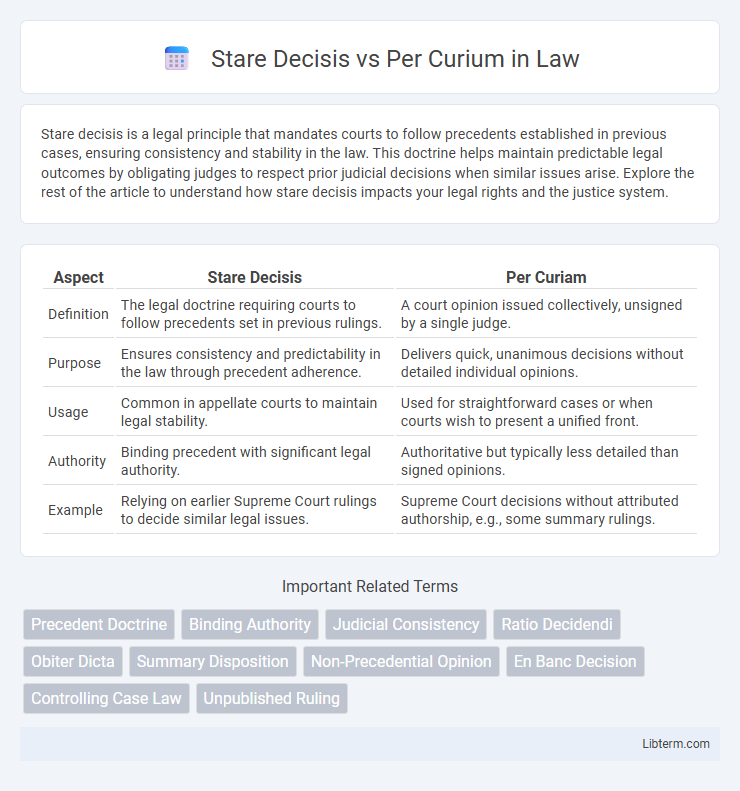Stare decisis is a legal principle that mandates courts to follow precedents established in previous cases, ensuring consistency and stability in the law. This doctrine helps maintain predictable legal outcomes by obligating judges to respect prior judicial decisions when similar issues arise. Explore the rest of the article to understand how stare decisis impacts your legal rights and the justice system.
Table of Comparison
| Aspect | Stare Decisis | Per Curiam |
|---|---|---|
| Definition | The legal doctrine requiring courts to follow precedents set in previous rulings. | A court opinion issued collectively, unsigned by a single judge. |
| Purpose | Ensures consistency and predictability in the law through precedent adherence. | Delivers quick, unanimous decisions without detailed individual opinions. |
| Usage | Common in appellate courts to maintain legal stability. | Used for straightforward cases or when courts wish to present a unified front. |
| Authority | Binding precedent with significant legal authority. | Authoritative but typically less detailed than signed opinions. |
| Example | Relying on earlier Supreme Court rulings to decide similar legal issues. | Supreme Court decisions without attributed authorship, e.g., some summary rulings. |
Understanding Stare Decisis: Definition and Importance
Stare decisis is a legal principle that mandates courts to follow precedents set by previous decisions, ensuring consistency and predictability in the law. Its importance lies in maintaining judicial stability and fairness by upholding established rulings, which guides lower courts and influences legal interpretation. Understanding stare decisis helps clarify how legal systems balance respect for precedent with the need for legal evolution.
Per Curiam: Meaning and Judicial Application
Per Curiam refers to a court opinion issued collectively by the judges of an appellate court, typically without individual authorship attribution, emphasizing the decision as a unified voice of the court. This method streamlines judicial communication, often used for straightforward cases or unanimous decisions, enhancing clarity and authority. Unlike Stare Decisis, which involves adherence to precedent for consistency, Per Curiam opinions focus more on the collective judgment and efficiency in delivering rulings.
Historical Evolution of Stare Decisis
The historical evolution of stare decisis reflects its deep roots in English common law, originating as a principle to ensure legal consistency and predictability by obliging courts to follow previous judicial decisions. Over time, stare decisis became a foundational doctrine in the United States legal system, guiding courts to respect precedent while allowing for adaptation in response to societal changes. Per curiam decisions, often brief and unsigned, differ by providing authoritative rulings without detailed opinions, typically used in uncontroversial cases or to uphold precedent established through stare decisis.
Key Features of Per Curiam Decisions
Per curiam decisions are unsigned rulings issued collectively by the court, often used for straightforward cases lacking extensive factual or legal complexity. These decisions typically provide concise opinions without detailed legal reasoning, aiming to expedite judicial processes and maintain institutional unity. Unlike stare decisis, which emphasizes adherence to precedent, per curiam opinions may depart from prior rulings without full explanation.
Stare Decisis in Legal Precedent Formation
Stare decisis is a cornerstone principle in legal precedent formation, ensuring courts adhere to established rulings to maintain consistency and predictability in the law. It compels lower courts to follow decisions made by higher courts within the same jurisdiction, promoting stability in legal interpretation. This doctrine contrasts with per curiam opinions, which are unsigned court rulings often used for straightforward cases without establishing binding precedents.
Per Curiam Versus Signed Opinions
Per Curiam opinions are brief, unsigned judicial decisions issued collectively by an appellate court, often for straightforward cases without extensive legal reasoning. In contrast, signed opinions feature the name of the authoring judge and provide detailed legal rationale, establishing precedent under the doctrine of stare decisis. Per Curiam decisions carry less precedential weight due to their summary nature, whereas signed opinions are integral to developing binding legal principles.
Impact of Stare Decisis on Case Outcomes
Stare Decisis, the legal principle of adhering to precedent, ensures consistency and predictability in judicial decisions by compelling courts to follow established rulings. This principle significantly impacts case outcomes by limiting judicial discretion and promoting stability in the legal system, thereby reducing variability across similar cases. In contrast, Per Curium opinions, typically unsigned and often addressing urgent or unanimous decisions, carry less precedential weight and usually do not establish binding precedent for future cases.
When Courts Choose Per Curiam Rulings
Courts choose per curiam rulings when a decision is straightforward, non-controversial, or when the legal principles are well-established under stare decisis, requiring no extended opinion. Per curiam opinions often expedite the judicial process by delivering a unanimous, concise ruling without attribution to a specific judge. This approach maintains consistency with precedent while efficiently resolving cases that do not necessitate detailed judicial analysis.
Comparative Analysis: Stare Decisis vs. Per Curiam
Stare decisis enforces judicial consistency by obligating courts to follow precedents set in previous rulings, promoting stability and predictability in the legal system. Per curiam decisions are brief, unsigned opinions issued collectively by a court, often used for straightforward cases without extensive legal reasoning or precedent analysis. While stare decisis emphasizes adherence to established case law, per curiam opinions focus on procedural efficiency and consensus, highlighting different judicial approaches to case resolution.
Implications for Future Judicial Decision-Making
Stare decisis, the principle of adhering to precedent, ensures stability and predictability in judicial decision-making by compelling courts to follow established rulings, which guides future case outcomes consistently. Per curiam decisions, often brief and unsigned, offer less authoritative weight and can signal flexibility or uncertainty in the law, influencing how lower courts interpret or apply such rulings. The tension between stare decisis and per curiam opinions shapes judicial strategies, balancing respect for precedent with the need for legal adaptability in evolving contexts.
Stare Decisis Infographic

 libterm.com
libterm.com